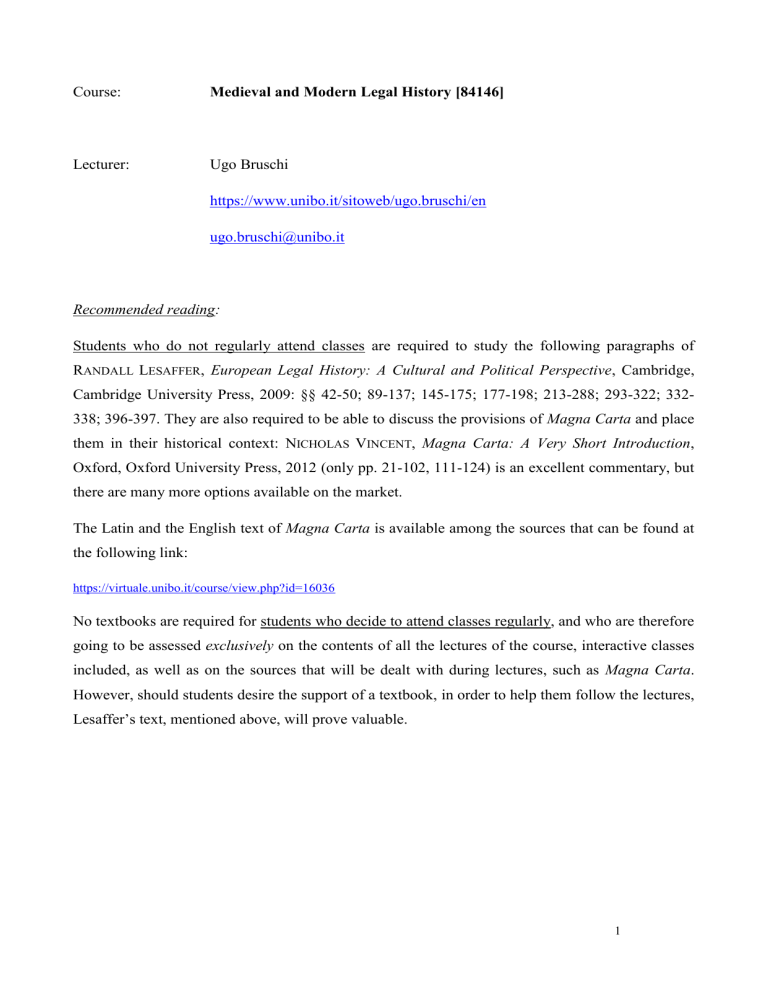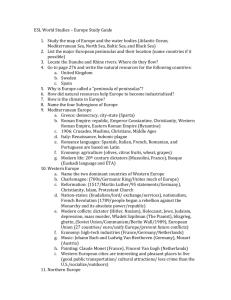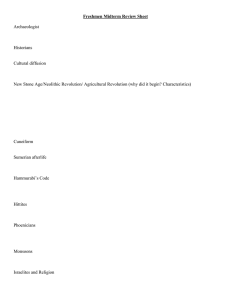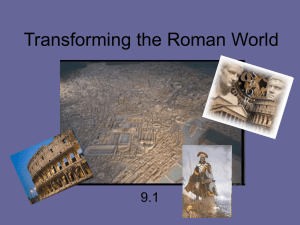
Course:
Medieval and Modern Legal History [84146]
Lecturer:
Ugo Bruschi
https://www.unibo.it/sitoweb/ugo.bruschi/en
ugo.bruschi@unibo.it
Recommended reading:
Students who do not regularly attend classes are required to study the following paragraphs of
RANDALL LESAFFER, European Legal History: A Cultural and Political Perspective, Cambridge,
Cambridge University Press, 2009: §§ 42-50; 89-137; 145-175; 177-198; 213-288; 293-322; 332338; 396-397. They are also required to be able to discuss the provisions of Magna Carta and place
them in their historical context: NICHOLAS VINCENT, Magna Carta: A Very Short Introduction,
Oxford, Oxford University Press, 2012 (only pp. 21-102, 111-124) is an excellent commentary, but
there are many more options available on the market.
The Latin and the English text of Magna Carta is available among the sources that can be found at
the following link:
https://virtuale.unibo.it/course/view.php?id=16036
No textbooks are required for students who decide to attend classes regularly, and who are therefore
going to be assessed exclusively on the contents of all the lectures of the course, interactive classes
included, as well as on the sources that will be dealt with during lectures, such as Magna Carta.
However, should students desire the support of a textbook, in order to help them follow the lectures,
Lesaffer’s text, mentioned above, will prove valuable.
1
The Periodization of History… and of Legal History
There are many possible periodizations in history, and none of them can claim to be objectively
true. The one which will be followed in this course is just one of the options, and it refers to western
(or, even more specifically, European) civilisation.
Generally speaking, a plausible periodization runs as follows:
until AD 476 [fall of the western Roman Empire] → Antiquity
476 – 1453 [fall of the eastern Roman Empire] or 1492 [discovery of America] → Middle Ages
The Middle Ages are often divided into early, high and late Middle Ages: the division can
vary a lot according to the area of Europe which is taken into account. In Italy the watershed
between high and late Middle Ages is sometimes set in the so-called peace of Constance
(1183).
1453/1492 – 1789 [end of ancient regime] → Early Modern Period
1789 [beginning of the French revolution] – 1914/1918 [WW1] or 1939/1945 [WW2] → Late
Modern Period
after 1918 or after 1945 → Contemporary history
The distinction between Early and Late Modern Period is typical of Anglo-American
historiography, as is the setting of Contemporary history in the 20th century. On the continent it is
more frequent to speak of ‘Modern Age’ (or Period), beginning in 1453 or 1492, and ending either
in 1789 or 1848 (i.e. the time of the European, sometimes dubbed ‘liberal’, revolutions),
immediately followed by the Contemporary period.
But as far as Legal History is concerned, another periodization may apply:
AD 284 [Diocletian and establishment of the dominate] – 527/565 [Justinian and the Corpus Iuris
Civilis] → Late Antiquity
568/9 [Lombard invasion of Italy] – 16th century [rise of modern, dynastic territorial state] →
Middle Ages, which must be divided, as far as legal history is concerned into High Middle Ages,
when Roman law all but disappears, and Late Middle Ages, with the renaissance of Roman law
(beginning with Irnerius, early 12th century), and the rise of ius commune
16th century – 1804 [Napoleonic Code] → Early Modern Period (a time marked by the crisis of ius
commune and by the long, difficult quest for a new legal system)
1804 – 1917 [codification of canon law] → Late Modern Period
after 1917 → Contemporary History
2
Part One
The decline of the Roman Empire
-
Diocletian (244-311), the dominate [deification of the emperor; rigid military and fiscal
system; powerful bureaucracy; descending theory of power; virtual monopoly of the
emperor in the making of laws] and the tetrarchy (293): two Augusti and two Caesares, with
four capitals (Nicomedia and Sirmium in the East; Milan and Augusta Treverorum in the
West)
-
the triumph of Christianity: Galerio’s edict of toleration (311) and Constantine the Great’s
(and Licinius’s) Edict of Milan in 313; the council of Nicæa (325), Catholicism > Arianism;
Theodosius the Great and the Edict of Thessalonica (380); the first Council of
Constantinople (381) → the influence of Christian thought on the binding character of law;
Empire and Church: the pope as a civil servant?
-
at Theodosius’s death († 395) the Roman Empire is permanently divided in a Western
Empire (until 402 Milan is the capital, and afterwards Ravenna) and Eastern Roman Empire
(capital Constantinople)
3
-
‘Germanic’ migrations (aka ‘Barbarian Invasions’: Huns, Goths, Vandals, Burgundians &c.
and their incursions into imperial territory); barbarian peoples/tribes as confederates (milites
foederati); their role as auxiliary forces of the empire; the rise of Germanic generals and the
title of patrician
-
the unification of the Goths under Alaric and the sack of Rome (410); the fall of the Western
Roman Empire, with the deposition (476) of the last emperor, Romulus Augustus, by
Odovacar, former foederatus officer, and then ‘king’; the behaviour of the Germanic tribes
and officers was not intended as an opposition against (the idea of) Empire: Odovacar and
Zeno, Eastern emperor
-
Theoderic the Great, king of the Ostrogoths (454-526), ousts (and kills...) Odovacar, settling
his people in Italy; Theoderic's edict: “Regnum nostrum imitatio vestra est”
4
Roman Law:
-
the difference between our contemporary idea of what law is (at least on continental Europe)
and the Roman one; Code and Codification: ambiguous words in legal history [papyrus]
-
the role of jurisprudence and of imperial legislation (constitutions) in the late Roman
empire; the ius respondendi
-
the first attempts of a systematization of Roman law: the law of citations (Papinian, Ulpian,
Modestinus, Gaius and Paul) promulgated in 426 by Theodosius II and Valentinian III; the
Codex Theodosianus (438)
-
Justinian (rules 527-565), Tribonian and the Corpus Iuris Civilis: the Old Code, a
collection of imperial constitutions (= Codex Iustinianus Primus or Vetus, 529, now lost
except for a fragment with an index showing that the law of citations was included), the
Digest (Digestum or Pandectae), an anthology of the best of Roman jurisprudence, which
was thus invested with statutory authority (530-533), the Institutes (Institutiones, 534) a
textbook on Roman law that, however, had force of law; the New Code (= Codex Repetitae
Praelectionis, 534), which supplanted the older one; and, finally, the Novellae, new
constitutions (usually in a Greek text) promulgated between the issue of the new code and
Justinian's death (no official collection of the Novellae existed, though)
-
under Justinian, Byzantine armies won back northern African territories that had been
formerly part of the Roman empire from the Vandals, and Italy from the Goths. However, in
order to reconquer Italy a long war was necessary (Gothic war, 535-553), which resulted in
the exhaustion of the inhabitants of Italy and the annihilation of its economy; on the other
hand, at the request of the pope Corpus Iuris Civilis was brought to Italy (Pragmatica
sanctio pro petitione Vigilii, 554)
5
The birth of European culture: a new civilisation
-
the interaction of Graeco-Roman, Judaeo-Christian, Germanic and Celtic cultures
-
Rome’s legacy and the ‘Barbarian kingdoms’: a weaker conception of sovereignty; the
disappearance of a central government, administration and fiscal system, as well as of the
concept of State; the strengthening of the domainial or manorial system; the law of the new
kingdoms (so-called ‘vulgarization’ of Roman law)
-
the integration between Germanic ‘invaders’ and the Romanised elites; the conversion of
Germanic people to Christianity and then to Catholicism
-
the rise of the Franks: their unification and the birth of a strong Frankish kingdom under
Clovis († 511): hereditary kingship and the monarch being both responsible for the welfare
of his people and holding the bannum, the right to command; the beginning of the alliance
between the Franks and Catholic Church. The role of assemblies; the Salic Law (Pactus
Legis Salicae) in its many versions (early 6th – later 8th cent.) and the Germanic idea of
criminal law: compositions and the role of the king.
-
a new role for the Church: pope Gelasius I (492-496) and his ‘principle’, expressed in a
letter to emperor Anastasius and in other works. According to Gelasius, two dignities (papal
and imperial) existed on earth, and it was necessary both that Christian emperors relied on
the popes for what pertained to eternal life, and that popes followed imperial decrees in
temporal life (“ut et Christiani imperatores pro aeterna vita pontificibus indigerent, et
pontifices pro temporalium cursu rerum imperialibus dispositionibus uterentur”) : “There
are two powers, august Emperor, by which this world is chiefly ruled, namely, the sacred
authority of the priests (auctoritas sacrata pontificum) and the royal power (regalis
potestas). Of these that of the priests is the weightier, since in the divine judgment they have
to render an account for even the kings of men”
-
pope Gregory the Great (590-604): the introduction of an ecclesiastical hierarchy throughout
western Europe, the role of monasticism and of the rule of Saint Benedict of Nursia, the
drive towards a unification of liturgy (calendar included) and theology
6
A watershed in legal history: the Lombard invasion of Italy
-
the Longobards (or Lombards) and their conquest (568-569) of the most part of central and
northern Italy, while the Byzantines retained the control of Ravenna and its territory (until
750-751) as well as of southern Italy
-
although at the time of their invasion, Lombard armies had been led by a king (Alboin),
central authority was usual less important than the traditional clan system (fara), and the
dukes (independent military and tribal leaders) were soon to regain the main authority after
the successful outcome of the invasion; only at the end of the 6th century monarchical
authority was restored under Authari and a capital town of the Lombard kingdom (Pavia)
was established, even though it meant something very different from our contemporary idea
of ‘capital town’ [Agilulf and Theodelinda]
-
during the reign of Rothari (reigns 636-652) customary law was dropped in favour of the
first example of Lombard written, half-statutory law, the edict of Rothari (643); it was
written in Latin, possibly by the clergy
-
remarkable features of the edict:
o its position in the evolution of Germanic laws, and in the relationship between
customary and statutory law, as well as ‘popular law’ [gairethinx] and the legislative
authority of the monarch;
o criminal law and the king’s intervention: blood feud and wergild;
7
o some civil law rules: women’s role, mundium (which entailed both authority over
someone, and the duty to take care of them) and marriage; the law of succession;
donations and the role of the launegild
o the Lombard trial and the role of oath and trial by battle
-
the evolution of Lombard monarchy and Liutprand’s rule (b. 690, king from 712 to 744), the
conversion of the Lombards to Catholicism and the effect on Lombard law as to marriage,
procedural law and last wills and testaments
-
the legacy of Lombard law: although after being defeated by Charlemagne, Lombard rulers
disappeared from most of Italy, their law was still to play a role in the following centuries,
and eventually had a say in the formation of ius commune
The twilight of Roman Law
-
outside Italy, the legacy of Roman law rested on the Codex Theodosianus, a compilation
which was less valuable when compared with the Corpus Iuris Civilis, especially as it did
not include any selection of Roman jurisprudence; in Italy, the Lombard invasion came as a
shock but, surprisingly, in a few years Justinian’s work had already managed to set deep
roots in the legal culture of Italy
-
Justinian’s compilation underwent a transformation, made of simplifications and
abridgement, but it was able to survive through the ‘age without jurists’, the early Middle
Ages: the Code lost its last three books (dealing with public law and therefore
unserviceable), and was abridged; the Institutes, thanks to their more basic approach,
sometimes even managed to make their way in the elementary education system of the time;
three unofficial collections of the Novellae circulated, the Greek one (168 constitutions in
the Greek text) being more successful in the East, while the Epitome Juliani (an abridged,
Latin version of 124 constitutions) was used in the West. The third collection, the
Authenticum, a literal, uncut translation of 134 constitutions was last heard of in Ravenna in
643: its revenge came in the 11th century, when it became the semi-official version thanks to
Irnerius. The Digest suffered the worst fate: it was last quoted in 603 in a letter by pope
Gregory the Great, and then it vanished until the 11th century.
-
in a way, Germanic law and vulgar Roman law intermingled, but the outcome was different
in northern Europe, when Germanic and Celtic customary laws were dominant, and in the
more romanised areas in the South, where the impact of Roman law was greater (the
dividing line ran through the middle of France)
-
it was an eclectic legal system, so much more as personal application of the law (as opposed
to territorial application) was current: in order to reduce the uncertainty and ambiguity that
might result by this situation, it was quite common to include in a contract a specific clause,
where each (or, more frequently, just a) party stated which law h/she was to follow
(professio iuris)
-
sometimes new texts appeared, such as the Summa Perusina (7th - 10th century), where
Roman law from different parts of Corpus Iuris was inextricably linked with Germanic law
8
Charlemagne and a new empire:
-
the decline of Frankish kingship under the late Merovingians and the rise of the mayors of
the palace, an office held by another dynasty, the Carolingians. The struggle against Arab
and Berber invaders and Charles Martel's victories (in 732 at Poitiers he had his most
celebrated triumph) increased their political stature. His grandson, Pippin the Short, in 750751 had the last Merovingian king deposed with the consent of the pope, Zacharias, and
began a new dynasty
-
meanwhile relations between popes and the Byzantines had reached breaking point,
especially due to the beginning of iconoclasm (726-842) under the emperor Leo III the
Isaurian (717-741): the pope needed a new protector
-
meanwhile (again!) the Lombards under king Astolf had finally conquered Ravenna (750751): the reaction of the Byzantine emperor Constantine V was sending pope Stephen II first
to Astolf, and then to Pippin
-
once in France, Stephen anointed Pippin and his two sons, Carloman and Charles, who is
better known as Charlemagne (742-814); what exactly did this anointment mean? Why does
the only contemporary source use the expression unctio in regem et patritios? Shall we read
this event as the creation of a new exarch?
-
the Church changed allegiance: Pippin first promised to uphold papal authority in Italy
(promissio Carisiaca, 754) and then crossed the Alps; Charlemagne, once ascended to the
throne, greatly expanded his kingdom (he completed the conquest of the Low Countries and
occupied Saxony) and in 774 defeated the Lombard armies. Frankish authority succeeded
the Lombard’s in central and northern Italy, but the dominion of the pope over Rome and
the surrounding territory was once and for all confirmed by Charlemagne. Perhaps the first
draft of the alleged ‘donation of Constantine’ dates back to this period (the 'donation' was a
forged privilege – circa before 850 – where the emperor granted to the Church extensive
rights over Italy and the western part of Roman empire)
-
on Christmas night, 800, pope Leo III crowned Charlemagne emperor: the nature of his
empire has long been discussed by historians. A plausible theory has it that, at least as far as
9
the Church was concerned, Charlemagne had been crowned Roman emperor ('Renovatio
Romani Imperii'), taking advantage of the fact that the Byzantine throne could be deemed
vacant (emperor Constantine VI having been deposed by his mother, Irene). The idea of the
unification of the Empire through a marriage of convenience between Charlemagne and
Irene was soon advanced, but it had to be dropped when Irene was in her turn deposed.
-
the conflict between Carolingian and Byzantine emperors came to an end with the treaty of
Aachen (812): Charlemagne's imperial status was recognized by the Byzantine envoys,
while he dropped any claim on the Roman imperial throne
-
whereas Charlemagne turned then to a more 'Germanic', concrete conception of empire (i.e.
emperor as suzerain of many different peoples, as king of kings), the Church stuck to the
idea of a universal authority of Empire, and of the transfer of the authority of the Roman
empire to the Franks (translatio imperii in Germanos)
-
character of the Carolingian empire:
o personal oaths of fealty to Charlemagne were repeatedly taken by all free men;
o imperial/royal patrimony (fiscus) was quite extended; on the other hand, lands and
offices were assigned to the aristocracy on a temporary basis and always reverted to the
monarch on the death of the holder;
o the empire was divided into ca. 300 pagi headed by a count; larger, more strategically
important counties, usually at the border, were called margraviates or marches, while an
even larger territory, the dukedom, usually corresponded to the lands controlled by a
single Germanic people: this structure survived the break-up of the Carolingian empire
in the second half of 9th century;
o the administration of justice: the role of the count and of the assemblies, mallus and
bannum, the aldermen (scabini); the increasing role of the monarch, who acted
coercively and who passed judgement; the Palatinate Court;
10
o imperial envoys (missi dominici) travelled painstakingly through the Empire' s
territories, acting both as assistants and as inspectors of the counts, sometimes also
sitting as judges; more often than not, these envoys were members of the clergy.
- the Carolingian renaissance and the law:
o Carolingian statute laws (capitularia) were promulgated by the monarch in the presence
of his nobles, who acted as 'the people'; some capitularia (legibus addenda) had to
emend an existing law (and possibly needed some sort of 'popular' approval), whereas
the capitularia per se scribenda addressed specific topics, usually introducing new rules;
o many capitularia dealt with the problems of the Church, which, far from resenting this
situation, was at a loss when, in the 10th century, this source of legislation came to an
end. Ecclesiastical reaction took then the form of a massive creation of false statutes,
usually attributed to the secular authority or to ancient popes, in order to fill the gap
whenever the Church needed a specific rule; the role of the tithe.
The feudal system:
-
Even though it was the Carolingian regime that laid the foundations of the feudal system, it
was when the Empire began to crumble away that it really caught on, spreading across
Europe in the 10th - 12th century. It had its roots in the custom of Germanic people, a society
in which a leader was surrounded by warriors who had sworn him fealty. It had a military
and administrative significance. Basically, a feudal relation entailed that a vassal swore
fealty to his liege (lord); in return the latter granted him his protection and tenure of land.
-
In the feudal system private and public law overlapped and their differentiation was
practically lost
-
the vassalage was the personal element:
o fealty (fidelitas) played a pivotal role in the whole relationship: it was established
with the oath of homage given in the commendation ceremony (commendatio) and it
meant that the vassal was ready to offer auxilium et consilium to his liege, i.e., aid
(especially military aid) and counsel (especially in the administration of the liege
lord's territory);
11
o the relation came to an end with the death of either the liege lord or the vassal, as
well as with a serious breach of trust
-
the beneficium, later called fief, was the real element:
o it normally consisted of a (sometimes vast) piece of land, usually belonging to fiscal
or ecclesiastical patrimony;
o it lasted for the lifetime of the vassal
o it enabled the vassal to arm a contingent of soldiers, especially knights on horseback,
whose importance was vital in medieval warfare (according to an old saying, the
introduction of stirrups had changed Europe's history)
-
traditionally, a third element (immunitas) is added: the vassal had a sort of monopoly on
jurisdiction and the collection of taxes in his fiefdom
-
also public offices were attracted in the feudal system, first given as beneficia by the liege
lord, and then with offices coming with large landholdings in the same territory, thus
granting vassals unprecedented power.
-
The liege lord was not necessarily the emperor or a king: local lords were ready in turn to
enter in a similar relation with smaller lords, even giving them part of the territory they had
received by their lord. Through these several layers of infeudation, a sort of pyramid was
built: at the top stood the supreme liege (suzerain), while sometimes most freemen in a
kingdom had their place in it, clerics included.
-
How did fiefs become hereditary?
o the rivalry between late Carolingians impaired the authority of the emperor and
resulted in a permanent weakening of the role of the suzerain
o in 877, the Carolingian king Charles the Bald granted his counts hereditary fiefs
(capitulary of Quierzy): although this concession had to be just on a personal basis,
and the right to inherit was limited to the counts’ sons or younger brothers, a custom
of hereditary succession developed
o in the 10th century a new wave of invasions/incursions hit central Europe: Vikings in
the north, Saracens in the south and, above all, Magyars or Hungarians (circa 898955). This led to the extensive building of castles and to the rise of a new social
class, the knights (milites)
o agricultural innovations (introduction of watermill and windmill; use of iron
mouldboard ploughs; the use of horses, alongside oxen, as draught animals; field
crop rotation) led to an increase in productivity; on the other hand, they asked for
stability in the tenure of land
o Edictum de beneficiis (1037) of emperor Conrad II granted also to sub-vassals (at
least in Italy) succession rights
12
Around AD 1000 - I / law and society
-
personal application of the law was still quite common
-
it was very unusual for new laws to be promulgated, as a result both of the severe weakening
of central authority and of the virtual disappearance of professional jurists
-
customary law had the lion’s share: it created the feudal system, as well as its economic
equivalent, the seigniorial system, an evolution of the manorial system, consisting of large
rural estates where a few free farmers and many more serfs cultivated the lands of a lord
(dominus). Soon the lords had certain privileges granted them by the royal authority; more
often, they simply began to hold a great political authority in the territory under their
control. One could say that they were usurping the king’s power; yet it could also be said
that they had appropriated it by custom.
-
custom was also very important as far as personal status was concerned, as well as to the
status of real estate
13
-
insofar as the study of law survived in this period, it was in the school of the seven liberal
arts, and especially in the trivium, grammar, dialectics (or logic) and rhetoric (whereas the
quadrivium included arithmetic, geometry, cosmology and music)
-
how did Roman law survive this dark age? usually abridged and mixed with customary law:
sometimes when sources refer to Lex Romana they do not mean ‘Roman law’, but just a
specific (now lost) compilation, entitled 'Lex Romana'
-
the Church was decisive in the preservation of Roman law: not only did the Church try to act
according to Roman law as much as possible (Ecclesia vivit lege Romana), but many
compilations of Roman law that circulated at that time had been written under the Church's
aegis
-
Adalbero, bishop of Laon, his Carmen ad Rotbertum regem (ca. 1024-31) and the idea of a
society in three tiers: the three orders of those who prayed, who fought and who toiled
(oratores, bellatores, laboratores), a distinction ordained by God and that had to be
preserved
Around AD 1000 - II/ authority and power:
-
a new Renovatio Imperii Romanorum: the Ottonian dynasty. This new Saxon dynasty was
born when the German king Henry I the Fowler neglected the Germanic custom of dividing
his kingdom between his sons, appointing as sole successor his son Otto I the Great (rules
936-973). Otto crushed the Magyars at Lechfeld in 955, conquered the kingdoms of Arles
and Italy, and in 962 was crowned emperor by the pope in Rome. The Holy Roman Empire
was born (even though the name was used only in 1254). It was the last Ottonian king, Otto
III (rules 996-1002), who most revived the ideal of Rome which had to play such an
important role in later philosophy of law
-
Otto I and his successors also tackled the crisis of the Church: the papacy had fallen into the
hands of Roman clans, thus losing control on ecclesiastical appointments, which had
consequently fallen under the control of regional secular (which often meant feudal)
authorities. The Ottonians decided to play an important role in the choice of ecclesiastical
dignitaries, as well as of the pope himself, in order to rescue him from the grasp of Roman
nobility. In the short run, this was doubtless beneficial to the Church's morals and even
freedom, but in the longer run it led to the Investiture Controversy.
-
the Ottonians employed the Church in the administration of their Empire, frequently
choosing bishops and abbots as their vassals, and consequently as rulers over large
territories. Not only did members of the clergy belong to the small educated elite of the
Empire, this system had even a greater advantage: clerics had no (legitimate at least) sons
who could claim a title to succession to the fief
-
the Ottonians also managed to recapture the imperial powers (regalia) from feudal lords, as
well as to achieve supremacy in the Empire; however, their success was ephemeral, as it was
founded on the cooperation of regional authority (whether they liked it or not). Emperors
acted as overlords, but they were not able to set up new institutions.
14





